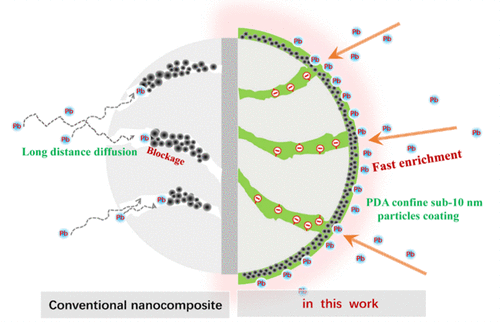当前位置:
X-MOL 学术
›
ACS ES&T Eng.
›
论文详情
Our official English website, www.x-mol.net, welcomes your
feedback! (Note: you will need to create a separate account there.)
Efficient Heavy Metal Removal from Water by Polydopamine Confined ZrO2 Nanocrystals with Improvements in Nanoparticles Utilization and Ion Diffusion
ACS ES&T Engineering ( IF 7.4 ) Pub Date : 2022-01-14 , DOI: 10.1021/acsestengg.1c00370 Zhixue Zhao 1 , Yaran Song 1 , Pikky Phanlavong 1 , Xuan Zhao 1 , Qiuming Peng 2 , Tifeng Jiao 1, 2 , Zhaoxiang Zhang 3 , Qingrui Zhang 1, 2, 3
ACS ES&T Engineering ( IF 7.4 ) Pub Date : 2022-01-14 , DOI: 10.1021/acsestengg.1c00370 Zhixue Zhao 1 , Yaran Song 1 , Pikky Phanlavong 1 , Xuan Zhao 1 , Qiuming Peng 2 , Tifeng Jiao 1, 2 , Zhaoxiang Zhang 3 , Qingrui Zhang 1, 2, 3
Affiliation

|
Nanocomposites for purification of trace heavy metal to the μg/L level remain a hard task and pressing matter, which is mainly challenged by their stable small size (<10 nm) formation and slow ion diffusion. To overcome these problems, we designed an engineered sub-10 nm nanocomposite with exceptional performances in heavy metal removal, e.g., Pb. It relies on a cooperative adsorption, originating from the fixation of charged SO3H groups and in situ external surface deposition of sub-10 nm ZrO2 nanocrystals over a polydopamine (PDA) layer. Not only does the PDA interface favor the formation of stable and active sub-10 nm ZrO2 nanocrystals, but also the external growth of nano-ZrO2 on the PDA layer further maximizes Zr utilization and shortens the heavy metal diffusion distance. In addition, the charged SO3H groups of the matrix can drive trace heavy metal ions from the bulk solution to the vicinity of absorbents with several orders of magnitude enrichment (∼31000 times), significantly increasing the interaction possibility between the sub-10 nm ZrO2 nanocrystals and the target heavy metals. These hybrid adsorbents exhibited superior selectivity with a distribution coefficient of 10500 mL/g, wide solution pH usage (∼2.0–7.0), rapid kinetics, and satisfactory filtration performances (>99.5% removal) in Pb removal. A remarkable capacity of ∼7240 L water/kg sorbent with low effluent (∼1 μg/L) was achieved in the treatment of the contaminated river stream, and the saturated adsorbents can be regenerated and reused with a negligible capacity loss. Our work therefore presents a new concept and benchmark for the lead(II) adsorbent and brings a new perspective for mitigating the problem of diverse heavy metal contamination.
中文翻译:

通过聚多巴胺限制的 ZrO2 纳米晶体有效去除水中的重金属,并改善了纳米粒子的利用和离子扩散
用于将微量重金属纯化至 μg/L 水平的纳米复合材料仍然是一项艰巨的任务和紧迫的任务,其主要挑战在于其稳定的小尺寸(<10 nm)形成和缓慢的离子扩散。为了克服这些问题,我们设计了一种工程化的亚 10 nm 纳米复合材料,在去除重金属(例如 Pb)方面具有出色的性能。它依赖于协同吸附,源自带电 SO 3 H 基团的固定和亚 10 nm ZrO 2纳米晶体在聚多巴胺 (PDA) 层上的原位外表面沉积。PDA界面不仅有利于形成稳定且有活性的亚10 nm ZrO 2纳米晶体,而且有利于纳米ZrO 2 的外部生长。在PDA层上进一步最大化Zr利用率并缩短重金属扩散距离。此外,基体中带电的 SO 3 H 基团可以将痕量重金属离子从本体溶液驱动到吸收剂附近,富集数个数量级(~31000 倍),显着增加了亚 10 nm 之间的相互作用可能性。氧化锆2纳米晶体和目标重金属。这些混合吸附剂表现出优异的选择性,分配系数为 10500 mL/g,溶液 pH 值使用范围广(~2.0-7.0),动力学快速,并且在 Pb 去除方面具有令人满意的过滤性能(>99.5% 去除)。在处理受污染的河流时,可实现约 7240 L 水/kg 吸附剂的显着容量(~1 μg/L),并且饱和吸附剂可以再生和重复使用,容量损失可忽略不计。因此,我们的工作为铅 (II) 吸附剂提出了新的概念和基准,并为缓解多种重金属污染问题带来了新的视角。
更新日期:2022-01-14
中文翻译:

通过聚多巴胺限制的 ZrO2 纳米晶体有效去除水中的重金属,并改善了纳米粒子的利用和离子扩散
用于将微量重金属纯化至 μg/L 水平的纳米复合材料仍然是一项艰巨的任务和紧迫的任务,其主要挑战在于其稳定的小尺寸(<10 nm)形成和缓慢的离子扩散。为了克服这些问题,我们设计了一种工程化的亚 10 nm 纳米复合材料,在去除重金属(例如 Pb)方面具有出色的性能。它依赖于协同吸附,源自带电 SO 3 H 基团的固定和亚 10 nm ZrO 2纳米晶体在聚多巴胺 (PDA) 层上的原位外表面沉积。PDA界面不仅有利于形成稳定且有活性的亚10 nm ZrO 2纳米晶体,而且有利于纳米ZrO 2 的外部生长。在PDA层上进一步最大化Zr利用率并缩短重金属扩散距离。此外,基体中带电的 SO 3 H 基团可以将痕量重金属离子从本体溶液驱动到吸收剂附近,富集数个数量级(~31000 倍),显着增加了亚 10 nm 之间的相互作用可能性。氧化锆2纳米晶体和目标重金属。这些混合吸附剂表现出优异的选择性,分配系数为 10500 mL/g,溶液 pH 值使用范围广(~2.0-7.0),动力学快速,并且在 Pb 去除方面具有令人满意的过滤性能(>99.5% 去除)。在处理受污染的河流时,可实现约 7240 L 水/kg 吸附剂的显着容量(~1 μg/L),并且饱和吸附剂可以再生和重复使用,容量损失可忽略不计。因此,我们的工作为铅 (II) 吸附剂提出了新的概念和基准,并为缓解多种重金属污染问题带来了新的视角。











































 京公网安备 11010802027423号
京公网安备 11010802027423号